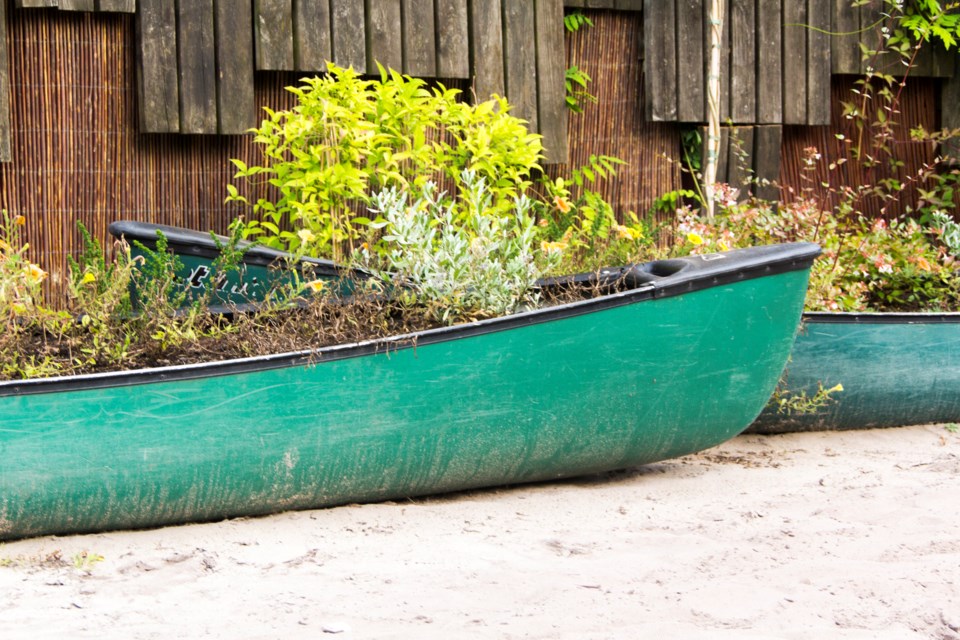We can all help bring nature home to our neighbourhoods. This story begins with a plan to crowdsource a network of do-it-yourself “national parks” and some keen community volunteers that filled a canoe with flowers.
A decade ago, volunteers planted a beat-up canoe, retired from active service, in a downtown Toronto green space at the Fort York historical site. They drilled it with holes for drainage, filled it with soil and transformed it into a planter filled with native wildflowers.
The initial aim was to plant canoes in parks and schoolyards along the old Garrison Creek, a “lost river” that had been incorporated into the city’s subterranean sewer system in the late 19th century. Each canoe would be a nod to the not-too-distant ecological past when the creek ran through the neighbourhood, and would provide much-needed habitat for local bees and butterflies.
Over the next three years, volunteers planted dozens of repurposed canoes throughout Toronto, Markham and Richmond Hill. Today, the canoe garden network stretches from Cape Breton to Vancouver Island, providing pollen and nectar patches for local critters and whimsical native plant demonstration gardens for passersby.
The idea to plant a canoe fleet was inspired by American author and entomologist Douglas Tallamy. In his book Bringing Nature Home, Tallamy offered a novel way to increase biodiversity in communities. Instead of relying on government agencies to establish green spaces like parks and conservation reserves, he encouraged residents to create “Homegrown National Parks.” Unlike traditional national parks, these loose patchworks of habitat would be citizen-led. They could be on private or public lands and, most importantly, planted with native plants, shrubs and trees that support local insects and wildlife.
The David Suzuki Foundation took up Tallamy’s challenge to create Canada’s first Homegrown National Park and enlisted the help of a couple dozen volunteers, including Toronto resident Aidan Dahlin Nolan, who became one of the first Homegrown Park Rangers in 2013.
After a few years of plantings, events and musical parades, the Homegrown National Park Project morphed into the Butterflyway Project in 2017. Still Ranger-powered, it’s expanded from a local greening initiative into a national network of volunteers creating butterfly-ways—neighbourhood-scale habitat corridors for pollinators and other wildlife.
It’s now come full circle. The David Suzuki Foundation is collaborating with the new U.S.-based Homegrown National Park organization Tallamy co-founded. People in Canada can now officially join this growing movement by uploading their native plant gardens to the Canadian Homegrown National Park Map. The goal is to highlight how much is happening on the ground—stitching together a growing international patchwork of individual actions into one inspiring movement.
The project is a lot of fun, but it’s motivated by troubling trends for the tiny creatures that run the world: insects. Despite being the planet’s largest and most diverse group of organisms, insect populations have dropped by 45 per cent over the past 40 years as a result of industrial agriculture, urbanization, invasive species and climate change. In rural areas, natural habitat has been replaced by monoculture crops maintained with chemical fertilizers and pesticides. Urban areas are characterized by impermeable surfaces, high temperatures and non-native vegetation—all of which lead to fewer insects.
The good news is that insect devastation isn’t inevitable. Each one of us can play a hands-on role in helping bring back local populations. Contributing to grassroots habitat-creation initiatives like the award-winning Butterflyway Project and adding plantings to the Homegrown National Park map are small, simple actions that, when multiplied by thousands of volunteers and groups and agencies, will make a big difference.
Tallamy is a scientist who is able to communicate complicated concepts, such as insect collapses and conservation, in simple and inspiring ways. Decades into his tireless efforts to bring nature home, he argues that the task is not as enormous as it seems. “You can’t reverse insect declines by yourself, but if we each do our own small part, not only can we restore insect populations, we will create the largest collective conservation effort in history,” he wrote in a 2020 Washington Post article.
All it takes is a couple of trays of native wildflowers, gardening gloves and a gentler approach to managing our yards and neighbourhoods—and perhaps an old canoe.
David Suzuki is a scientist, broadcaster, author and co-founder of the David Suzuki Foundation. Written with contributions from David Suzuki Foundation Senior Strategist Jode Roberts. Learn more at davidsuzuki.org.




